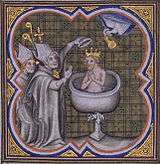Ampoule
An ampoule (also ampul, ampule, or ampulla) is a small sealed vial which is used to contain and preserve a sample, usually a solid or liquid. Ampoules are commonly made of glass, although plastic ampoules do exist.
Modern ampoules are most commonly used to contain pharmaceuticals and chemicals that must be protected from air and contaminants. They are hermetically sealed by melting the thin top with an open flame, and usually opened by snapping off the neck. If properly done, this last operation creates a clean break without any extra glass shards or slivers; but the liquid or solution may be filtered for greater assurance. Glass particle contamination is of ongoing concern, with patients who receive medication parenterally, such as intravenously under hospital care, at greater risk of receiving glass particulates when medication is aspirated.[1] The space above the chemical may be filled with an inert gas before sealing. The walls of glass ampoules are usually sufficiently strong to be brought into a glovebox without any difficulty.
Glass ampoules are more expensive than bottles and other simple containers, but there are many situations where their superior imperviousness to gases and liquids and all-glass interior surface are worth the extra cost. Examples of chemicals sold in ampoules are injectable pharmaceuticals, air-sensitive reagents like tetrakis(triphenylphosphine)palladium(0), hygroscopic materials like deuterated solvents and trifluoromethanesulfonic acid, and analytical standards.
Historic ampoules

Historically ampoules were used to contain a small sample of a person's blood after death, which was entombed alongside them in many Christian catacombs. It was originally believed that only martyrs were given this burial treatment, though it is suspected to have been a widely practiced tradition.
San Gennaro
An ampoule, allegedly dating back to the year 305 and filled with the blood of Saint Januarius (San Gennaro), bishop of Benevento, has been kept for centuries in the Cathedral at Naples. Every year on 19 September the town celebrates the Feast of San Gennaro, when the solid reddish-brown contents of the ampoule usually liquifies after being taken out of a safe, carried in procession and placed on the Cathedral's altar.[2]
Sainte Ampoule

Another well known ampoule is the Holy Ampulla (Sainte Ampoule) which held the anointing oil for the coronation of the French monarchs. The oil was allegedly passed down from the time of Clovis I; it was kept for a time in the tomb of Saint Remigius and later in the Cathedral of Notre-Dame, Reims. It was used in coronation of Charles X.
Production
Modern glass ampoules are produced industrially from short lengths of glass tubing, shaped by heating with gas torches and gravity in automated production lines. Computer vision techniques are usually employed for quality control.
The filling and sealing of ampoules may be done by automated machinery on an industrial scale, or by hand in small-scale industries and laboratory. Blank ampoules can be purchased from scientific glass supply houses and sealed with a small gas torch. This forms a membrane allowing someone to turn the open ampule upside down without spilling. A Schlenk line may be used for sealing under inert atmospheres. There is procedure of purging nitrogen before and after filling liquid into ampoules in order to remove atmospheric air available inside the ampoules. Ampoule filling machines can be categorized in three categories called automatic machine, semi automatic machine and manual (hand operated) machines.
Other uses
Ampoules are common practice as containers of low frequency RFID tags. These are used mainly for tagging animals, such as dogs for identification.
Ampoule codes
Ampoules often have colored rings of paint or enamel around their necks. Color coding of modern ampoules is done during the manufacturing process. A machine paints colored rings on the ampoule shortly after it has been sealed. The rings are made of a substance that is readable by other machines. These color codes identify the substance inside the ampoule so that it does not need to be tested to verify the contents. The machine-readable color codes allow for accurate handling of the substance for the purposes of storage, labeling, and secondary packaging.[3]
The dot above the neck identifies the location of a small cut in the glass to help breaking/opening the ampoule.
See also
References
- Hans-Jürgen Bässler und Frank Lehmann : Containment Technology: Progress in the Pharmaceutical and Food Processing Industry. Springer, Berlin 2013, ISBN 978-3642392917
- ↑ Glass particle contamination: is it here to stay? S. T. Lye et al, Volume 58, Issue 1 January 2003 Pages 93–94
- ↑ Thurston, Herbert (1910) "Saint Januarius" entry in the Catholic Encyclopedia, Vol. 8. New York: Robert Appleton Company, 1910. Online version accessed on 2009-06-20.
- ↑ http://www.bausch-stroebel.com/en/coding--a_code.html
| Wikimedia Commons has media related to Ampoules. |